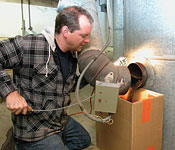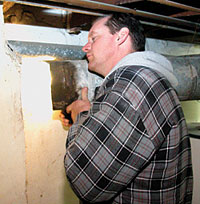
Smith determined that the chimney was completely blocked. All of the combustion products were emptying into the basement, where two of the five children in the home slept.
"There was spillage from the boiler and water heater - 100 percent into the basement," said Smith. "I think the kids' beds were about 15 feet from the boiler."
He said he learned about checking the draft diverter from his boss, Dave Yates, president of F.W. Behler. After identifying the chimney flue as the culprit, Smith proceeded to clean the debris from the bottom of the chimney, also a routine function of his job.

Checking For CO
Smith, who began working for Behler 10 years ago, said checking for combustion problems is second nature to him, as it is for most service techs.Smith usually carries a Bacharach carbon monoxide (CO) tester and a UEI combustion analyzer with him on service calls. "Basically anyone can use test equipment and tell what CO levels are," he stated.
"I don't know why more techs don't use this equipment. I can only speak for myself - this is what I've been taught to do."
Although CO is an odorless and colorless byproduct of incomplete combustion, Smith said he can often tell there is a CO problem when he walks into a home before he breaks out his testing equipment.
"Some of the high levels of CO are pretty obvious," he said. "You are smelling other products of combustion, like a stenchy smell. It is hard to describe."
Smith said older homes with brick chimneys are especially susceptible to combustion-related problems.
"Condensation builds up in the chimneys, which eats at the brick and mortar, and the bricks start falling down," he said. "Birds also make a mess in the chimneys. It is not uncommon to go into a home and find a partially blocked chimney - you always want to check this.

Besides recommending homeowners or landlords have their chimneys checked every year, Smith recommends placing a CO detector in the hallway or near the steps leading to the basement.
"I also show people how to check the diverter, too," he said.
Yates said Smith's actions come as no surprise to him. "He's a real success story," said Yates. "He devours RSES journals like most people would devour candy. His diligence has advanced him to being one of our top techs."
Yates noted that the recent service call was nothing unusual for Smith. "This is just one of several fine CO catches Sean has had this year," he said.
In this case, the mother told Smith that her kids had been sick recently, and their pediatrician did not know why.
After the service call, Smith called back to follow up and see how the family was doing. "She said the kids had no other medical problems and were showing no symptoms," he said.
Checking for proper venting and combustion is part of an overall 33-point checklist for HVAC equipment installers. For a free copy, contact John R. Hall at johnhall@achrnews.com.
Publication date: 12/13/2004



